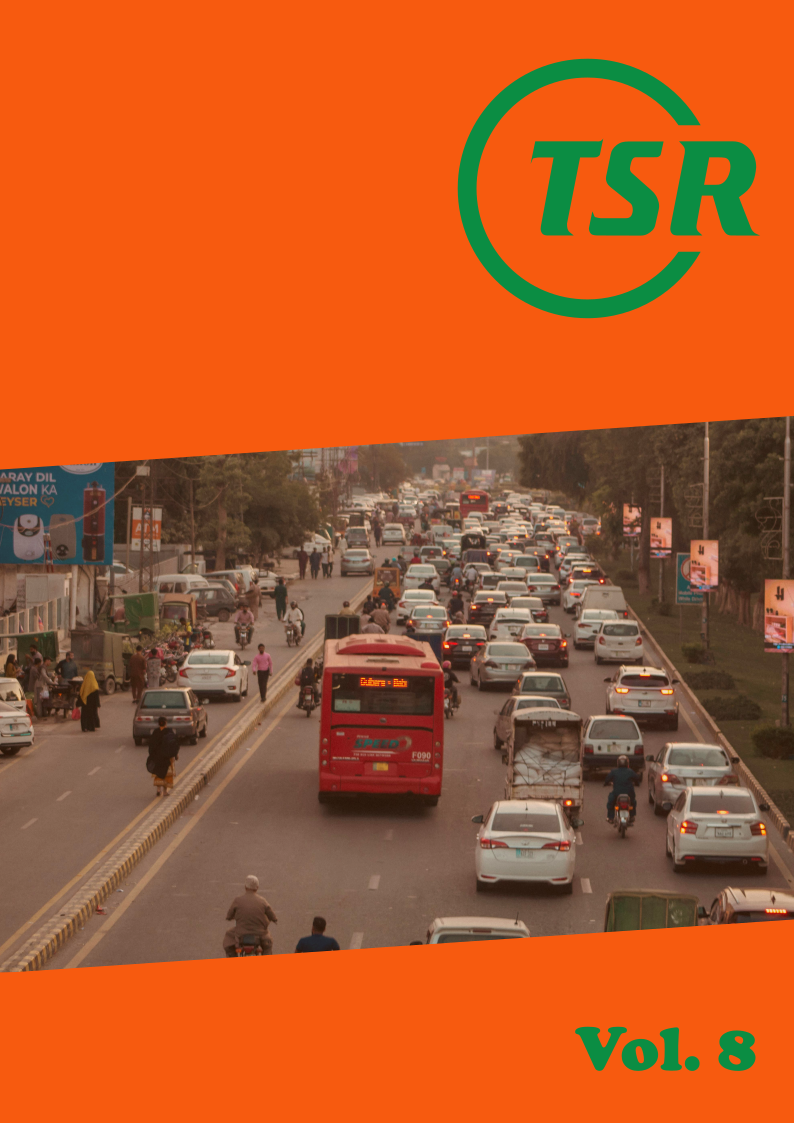Using crowdsourced data to assess safety in developing countries: the case study of Eastern Cairo, Egypt
DOI:
https://doi.org/10.55329/yzsq3960Keywords:
crowdsourced data, Full Bayes models, network screening, road crashes, safety performance functionsAbstract
Crowdsourced data refers to data that is collected and shared by a large number of individuals or organizations, often through the use of digital technologies such as mobile devices and social media. The shortage in crash data collection in developing countries makes it difficult to fully understand and address road safety issues in these regions. In developing countries, crowdsourced data can be a valuable tool for collecting crash data and improving road safety, particularly in urban areas where the majority of road crashes occur. This study is the first to develop safety performance functions using crowdsourced data by adopting a Negative Binomial structure model and Full Bayes (FB) model to investigate traffic safety for urban road networks and provide insights into the impact of roadway characteristics. Furthermore, as a part of the safety management process, network screening has been undergone through applying two different methods to rank the most hazardous road segments: Potential Collision Reduction (PCR) method (adopted in the Highway Safety Manual (HSM)) as well as a graphical method using GIS tools to compare and validate. The analysis revealed that segment length, number of lanes, and pedestrian density were significant factors positively associated with crash frequency. FB models with spatial correlation showed better performance in terms of logic and model fit compared to traditional models. The analysis found that both PCR and GIS-based kriging methods effectively identified hazardous segments, with kriging using summation criteria providing more consistent results when validated against PCR outcomes. Recommendations were proposed to improve pedestrian behavior, and control access points and U-turns, based on the observed impact on safety. Lastly, recommendations were suggested for policymakers to ensure safer roads and limitations regarding data coverage and the need for complementary official crash data were highlighted to guide future research.
Downloads
References
Abdel-Aty, M., & Radwan, A. E. (2000). Modeling traffic accident occurrence and involvement. Accident Analysis and Prevention, 32(5), 633–642. DOI: https://doi.org/10.1016/S0001-4575(99)00094-9
Abdelrahman, A., Abdel-Aty, M., Lee, J., Yue, L., & Al-Omari, M. M. A. (2020). Evaluation of displaced left-turn intersections. Transportation Engineering, 2, 100006. DOI: https://doi.org/10.1016/j.treng.2020.100006
Alluri, P., & Ogle, J. (2012). Effects of state-specific SPFs, AADT estimations, and overdispersion parameters on crash predictions using Safety Analyst. 91st Annual Meeting of the Transportation Research Board, Washington, D.C.
Al-Omari, M. M. A., Abdel-Aty, M., & Chen, Q. (2021). Crash analysis and development of safety performance functions for Florida roads in the framework of the context classification system. Journal of Safety Research, 77, 240–249. DOI: https://doi.org/10.1016/j.jsr.2021.08.004
Asal, H., & Said, D. (2019). An approach for development of local safety performance functions for multi-lane rural divided highways in Egypt. Transportation Research Record, 2673(10), 510–521. DOI: https://doi.org/10.1177/0361198119849914
Azizi, L., & Sheikholeslami, A. (2013). Safety effect of U-turn conversions in Tehran: Empirical Bayes observational before-and-after study and crash prediction models. Journal of Transportation Engineering, 139(1), 101–108. DOI: https://doi.org/10.1061/(ASCE)TE.1943-5436.0000469
Bornheimer, C., Schrock, S. D., Wang, M. H., & Lubliner, H. (2012). Developing a regional safety performance function for rural two-lane highways. 91st Annual Meeting of the Transportation Research Board, Washington, D.C.
Brimley, B., Saito, M., & Schultz, G. (2012). Calibration of Highway Safety Manual safety performance function: Development of new models for rural two-lane two-way highways. Transportation Research Record: Journal of the Transportation Research Board, 2279(1), 82–89. DOI: https://doi.org/10.3141/2279-10
Cafiso, S., Montella, A., D’Agostino, C., Mauriello, F., & Galante, F. (2021). Crash modification functions for pavement surface condition and geometric design indicators. Accident Analysis & Prevention, 148, 105853. DOI: https://doi.org/10.1016/j.aap.2020.105887
CAPMAS. (2024). Quarterly Management Statistical Overview of Central Agency for Public Mobilization and Statistics.
Carter, D., Hummer, J. E., Foyle, R. S., & Phillips, S. (2005). Operational and safety effects of U-turns at signalized intersections. Transportation Research Record: Journal of the Transportation Research Board, 1912(1), 11–18. DOI: https://doi.org/10.1177/0361198105191200102
D’Agostino, C., Cafiso, S., & Kiec, M. (2019). Comparison of Bayesian techniques for the before–after evaluation of the safety effectiveness of short 2+1 road sections. Accident Analysis & Prevention, 125, 152–162. DOI: https://doi.org/10.1016/j.aap.2019.02.009
De Souza, A. M., Brennand, C. A. R. L., Yokoyama, R. S., Donato, E. A., Madeira, E. R. M., & Villas, L. A. (2017). Traffic management systems: classification, review, challenges, and future perspectives. International Journal of Distributed Sensor Networks, 13(4), Article 1550147716683612. DOI: https://doi.org/10.1177/1550147716683612
Elagamy, S. R., El-Badawy, S. M., Shwaly, S. A., Zidan, Z. M., & Elrawy, U. (2020). Segmentation effect on developing safety performance functions. Innovative Infrastructure Solutions, 5(3), 1–10. DOI: https://doi.org/10.1007/s41062-020-00318-7
El-Basyouny, K., & Sayed, T. (2010). Full Bayes approach to before-and-after safety evaluation with matched comparisons: Case study of stop-sign in-fill program. Transportation Research Record: Journal of the Transportation Research Board, 2148(1), 1–8. DOI: https://doi.org/10.3141/2148-01
ERS. (2018). The Egyptian Code for The Standards of Design and Requirements for Implementing Urban and Rural Road Works.
ESRI. (2024). How Kriging Works.
Farid, A., Abdel-Aty, M., & Lee, J. (2018). A new approach for calibrating safety performance functions. Accident Analysis & Prevention, 119, 188–194. DOI: https://doi.org/10.1016/j.aap.2018.07.023
Farid, A., Abdel-Aty, M., Lee, J., & Eluru, N. (2017). Application of Bayesian informative priors to enhance the transferability of safety performance functions. Journal of Safety Research, 62, 155–161. DOI: https://doi.org/10.1016/j.jsr.2017.06.005
Farrag, M., Heikal, A., Shawky, M., & Osama, A. (2022). Investigation of road safety using crowdsourcing and internet-based surveys: Cairo, Egypt, as a case study. Advances in Transportation Studies.
Ferster, C. J., Nelson, T., Robertson, C., & Feick, R. (2018). Current Themes in Volunteered Geographic Information. In Comprehensive Geographic Information Systems (pp. 26–41). Elsevier. DOI: https://doi.org/10.1016/B978-0-12-409548-9.09620-2
Fitzpatrick, K., Lord, D., & Park, B. J. (2008). Accident modification factors for medians on freeways and multilane rural highways in Texas. Transportation Research Record: Journal of the Transportation Research Board, 2083(1), 62–71. DOI: https://doi.org/10.3141/2083-07
Flynn, D. F. B., Gilmore, M. M., Dolan, J. P., Teicher, P., & Sudderth, E. A. (2022). Using crowdsourced data to improve models of traffic crash propensity: Tennessee Highway Patrol case study. Transportation Research Record, 2676(8), 267–278. DOI: https://doi.org/10.1177/03611981221083305
Flynn, D. F. B., Gilmore, M. M., & Sudderth, E. A. (2018). Estimating traffic crash counts using crowdsourced data: Pilot analysis of 2017 Waze data and police accident reports in Maryland (Tech. Rep. No. DOT-VNTSC-BTS-19-01). John A. Volpe National Transportation Systems Center, U.S. Department of Transportation.
Garber, N. J., Rivera, G., & Lim, I. K. (2011). Safety performance functions for intersections in Virginia. 91st Annual Meeting of the Transportation Research Board, Washington, D.C.
HSM. (2010). Highway Safety Manual. American Association of State Highway & Transportation Officials (AASHTO).
Intini, P., Berloco, N., Cassano, G., Lord, D., Ragnoli, V., & Colonna, P. (2021). The variability of urban safety performance functions for different road elements: An Italian case study. European Transport Research Review, 13, 45. DOI: https://doi.org/10.1186/s12544-021-00490-6
Kaaf, K. A., & Abdel-Aty, M. (2015). Transferability and calibration of Highway Safety Manual performance functions and development of new models for urban four-lane divided roads in Riyadh, Saudi Arabia. Transportation Research Record, 2515(1), 70–77. DOI: https://doi.org/10.3141/2515-10
Kamel, M. B., Sayed, T., & Osama, A. (2019). Accounting for mediation in cyclist-vehicle crash models: A Bayesian mediation analysis approach. Accident Analysis and Prevention, 131, 122–130. DOI: https://doi.org/10.1016/j.aap.2019.06.009
Li, X., Liu, J., Yang, C., & Gates, T. (2021). Bayesian approach to developing context-based crash modification factors for medians on rural four-lane roadways. Transportation Research Record, 2675(9), 1316–1330. DOI: https://doi.org/10.1177/03611981211007141
Manuel, A., El-Basyouny, K., & Islam, M. T. (2014). Investigating the safety effects of road width on urban collector roadways. Safety Science, 62, 305–311. DOI: https://doi.org/10.1016/j.ssci.2013.09.005
Martinelli, F., La Torre, F., & Vadi, P. (2009). Calibration of the Highway Safety Manual’s accident prediction model for the Italian secondary road network. Transportation Research Record: Journal of the Transportation Research Board, 2103(1), 1–9. DOI: https://doi.org/10.3141/2103-01
Mohammadi, M. A., Samaranayake, V. A., & Bham, G. H. (2014). Crash frequency modeling using negative binomial models: An application of generalized estimating equation to longitudinal data. Analytic Methods in Accident Research, 2, 52–69. DOI: https://doi.org/10.1016/j.amar.2014.07.001
Moomen, M., Mahdi, R., Mustaffa, N. R., & Khaled, K. (2019). Predicting injury severity and crash frequency: Insights into the impacts of geometric variables on downgrade crashes in Wyoming. Journal of Traffic and Transportation Engineering (English Edition), 7(3), 375–383. DOI: https://doi.org/10.1016/j.jtte.2019.04.002
Naseri, M. A. (2018). Adopting and incorporating crowdsourced traffic data in advanced transportation management. Iowa State University Capstones, Theses and Dissertations.
Nasser, M. A., Ahmed, S. E., Abdallah, H. W., & Mohamed, A. E. (2016). Analysis of accidents cost in Egypt using the willingness-to-pay method. International Journal of Traffic and Transportation Engineering, 5(1), 10–18.
Nelson, T. A., Denouden, T., Jestico, B., Laberee, K., & Winters, M. (2015). BikeMaps.org: A global tool for collision and near miss mapping. Frontiers in Public Health, 3, Article 53. DOI: https://doi.org/10.3389/fpubh.2015.00053
Rahman, Z., Mattingly, S. P., Kawadgave, R., Nostikasari, D., Roeglin, N., Casey, C., & Johnson, T. (2019). Using crowdsourcing to locate and characterize conflicts for vulnerable modes. Accident Analysis & Prevention, 128, 32–39. DOI: https://doi.org/10.1016/j.aap.2019.03.014
Sacchi, E., & Sayed, T. (2016). Conflict-based safety performance functions for predicting traffic collisions by type. Transportation Research Record: Journal of the Transportation Research Board, 2583(1), 53–60. DOI: https://doi.org/10.3141/2583-07
Silva, T. H., De Melo, P. O. V., Viana, A. C., Almeida, J. M., Salles, J., & Loureiro, A. A. (2013). Traffic condition is more than colored lines on a map: Characterization of Waze alerts. In A. Jatowt, E.-P. Lim, & T. H. Silva (Eds.), Proceedings of the 5th International Conference on Social Informatics (SocInfo 2013) (pp. 309–318). Springer International Publishing. DOI: https://doi.org/10.1007/978-3-319-03260-3_27
Srinivasan, R., Colety, M., Bahar, G., Crowther, B., & Farmen, M. (2016). Estimation of calibration functions for predicting crashes on rural two-lane roads in Arizona. Transportation Research Record, 2583(1), 17–24. DOI: https://doi.org/10.3141/2583-03
Stylianou, K., Dimitriou, L., & Abdel-Aty, M. (2019). Big data and road safety: A comprehensive review. In C. Antoniou, L. Dimitriou, & F. Pereira (Eds.), Mobility patterns, big data and transport analytics: Tools and applications for modeling (pp. 297–343). Elsevier. DOI: https://doi.org/10.1016/B978-0-12-812970-8.00012-9
Surapunt, T., & Wang, S. (2024). Ensemble modeling with a Bayesian maximal information coefficient-based model of Bayesian predictions on uncertainty data. Information, 15(4), 228. DOI: https://doi.org/10.3390/info15040228
Tegge, R. A., Jo, J. H., & Ouyang, Y. (2010). Development and application of safety performance functions for Illinois [Research Report]. Illinois Center for Transportation.
Telima, M., El Esawey, M., El-Basyouny, K., & Osama, A. (2023). The use of crowdsourcing data for analyzing pedestrian safety in urban areas. Ain Shams Engineering Journal, 14(6), 102140. DOI: https://doi.org/10.1016/j.asej.2023.102140
Veeramisti, N., Paz, A., & Baker, J. (2020). A framework for corridor-level traffic safety network screening and its implementation using business intelligence. Safety Science, 121, 100–110. DOI: https://doi.org/10.1016/j.ssci.2019.08.042
Wang, H., Chen, C., Wang, Y., Pu, Z., & Lowry, M. B. (2016). Bicycle safety analysis: Crowdsourcing bicycle travel data to estimate risk exposure and create safety performance functions. Final Draft: Pacific Northwest Transportation Consortium.
WHO. (2016). World Health Organization Global Status Report on Road Safety.
WHO. (2023). World Health Organization Global Status Report on Road Safety.
Yao, J., & Park, P. Y. (2014). Hot-zone identification with GIS-based post-network screening analysis. Journal of Transport Geography, 34, 106–120. DOI: https://doi.org/10.1016/j.jtrangeo.2013.11.007
Published
How to Cite
Issue
Section
License
Copyright (c) 2025 Mahmoud Ahmed Farrag, Ali Zain Elabdeen Heikal, Mohamed Shawky Ahmed, Ahmed Osama Amer

This work is licensed under a Creative Commons Attribution 4.0 International License.











